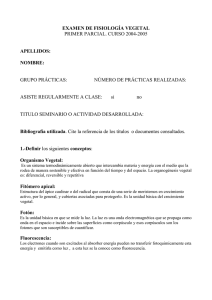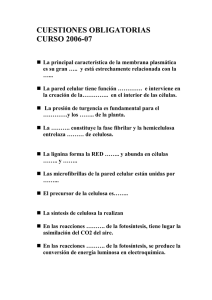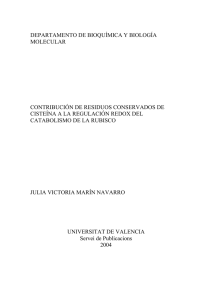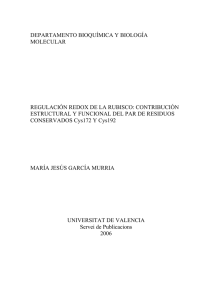05.83.pdf
Anuncio
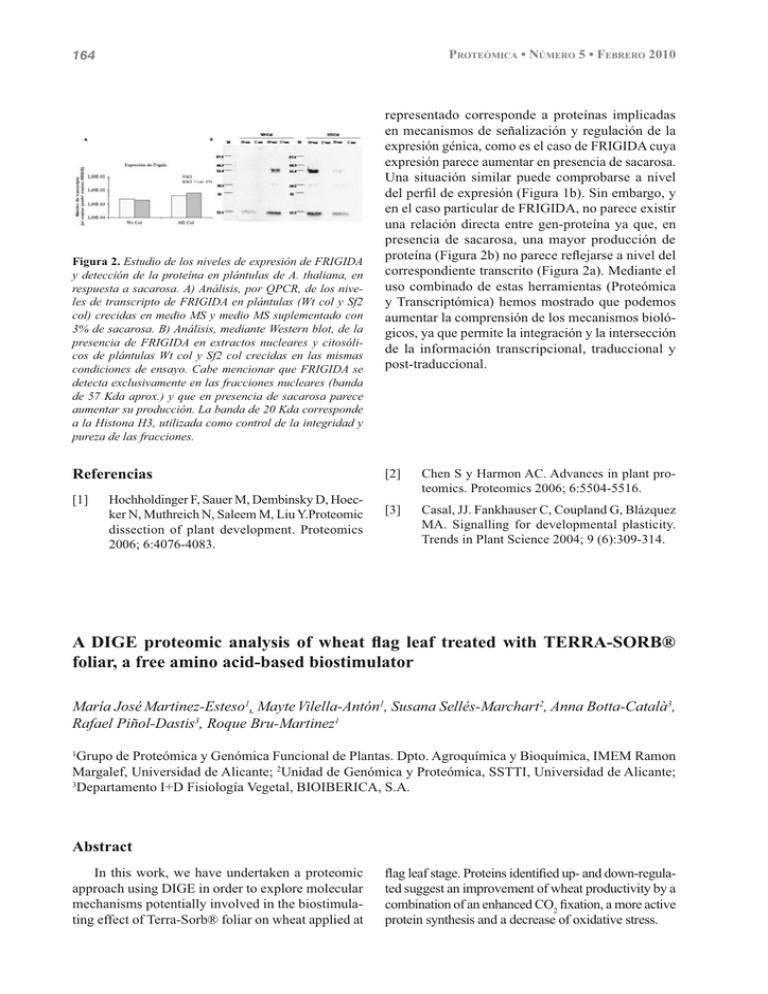
164 3527(Ï0,&$1Ò0(52)(%5(52 Figura 2. Estudio de los niveles de expresión de FRIGIDA y detección de la proteína en plántulas de A. thaliana, en respuesta a sacarosa. A) Análisis, por QPCR, de los niveles de transcripto de FRIGIDA en plántulas (Wt col y Sf2 col) crecidas en medio MS y medio MS suplementado con 3% de sacarosa. B) Análisis, mediante Western blot, de la presencia de FRIGIDA en extractos nucleares y citosólicos de plántulas Wt col y Sf2 col crecidas en las mismas condiciones de ensayo. Cabe mencionar que FRIGIDA se detecta exclusivamente en las fracciones nucleares (banda de 57 Kda aprox.) y que en presencia de sacarosa parece aumentar su producción. La banda de 20 Kda corresponde a la Histona H3, utilizada como control de la integridad y pureza de las fracciones. Referencias [1] Hochholdinger F, Sauer M, Dembinsky D, Hoecker N, Muthreich N, Saleem M, Liu Y.Proteomic dissection of plant development. Proteomics 2006; 6:4076-4083. representado corresponde a proteínas implicadas en mecanismos de señalización y regulación de la expresión génica, como es el caso de FRIGIDA cuya expresión parece aumentar en presencia de sacarosa. Una situación similar puede comprobarse a nivel GHOSHU¿OGHH[SUHVLyQ)LJXUDE6LQHPEDUJR\ en el caso particular de FRIGIDA, no parece existir una relación directa entre gen-proteína ya que, en presencia de sacarosa, una mayor producción de SURWHtQD)LJXUDEQRSDUHFHUHÀHMDUVHDQLYHOGHO correspondiente transcrito (Figura 2a). Mediante el uso combinado de estas herramientas (Proteómica y Transcriptómica) hemos mostrado que podemos aumentar la comprensión de los mecanismos biológicos, ya que permite la integración y la intersección de la información transcripcional, traduccional y post-traduccional. [2] Chen S y Harmon AC. Advances in plant proteomics. Proteomics 2006; 6:5504-5516. [3] Casal, JJ. Fankhauser C, Coupland G, Blázquez MA. Signalling for developmental plasticity. Trends in Plant Science 2004; 9 (6):309-314. $ ',*( SURWHRPLF DQDO\VLV RI ZKHDW ÀDJ OHDI WUHDWHG ZLWK 7(55$625% foliar, a free amino acid-based biostimulator María José Martinez-Esteso1, Mayte Vilella-Antón1, Susana Sellés-Marchart2, Anna Botta-Català3, Rafael Piñol-Dastis3, Roque Bru-Martinez1 1 Grupo de Proteómica y Genómica Funcional de Plantas. Dpto. Agroquímica y Bioquímica, IMEM Ramon Margalef, Universidad de Alicante; 2Unidad de Genómica y Proteómica, SSTTI, Universidad de Alicante; 3 Departamento I+D Fisiología Vegetal, BIOIBERICA, S.A. Abstract In this work, we have undertaken a proteomic approach using DIGE in order to explore molecular mechanisms potentially involved in the biostimulating effect of Terra-Sorb® foliar on wheat applied at ÀDJOHDIVWDJH3URWHLQVLGHQWL¿HGXSDQGGRZQUHJXODted suggest an improvement of wheat productivity by a combination of an enhanced CO2¿[DWLRQDPRUHDFWLYH protein synthesis and a decrease of oxidative stress. 165 3527(Ï0,&$1Ò0(52)(%5(52 Table 1. 3URWHLQVGHUHJXODWHGLQZKHDWÀDJOHDIWUHDWHGZLWK7HUUD6RUE)ROLDU1RUPDOLVHGVSRWVYROXPHVIRU&21752/ and TREATED samples. Protein Information Ref. Spot Protein Description Norm. Vol. Accession No. CONTROL Terra-Sorb 73 EF-Tu Chl-1 translational elongation factor Tu 125540125 1 1,412 10 EF-Tu Chl-2 14 EF-Tu Chl-3 translational elongation factor Tu translational elongation factor Tu 125540125 125540125 1 1 1,371 1,301 18 RUBISCO LBP-B-1 RuBisCO large subunit-binding protein subunit beta, chloroplast 2493650 1 1,256 122 RUBISCO LBP-B-2 RuBisCO large subunit-binding protein subunit beta, chloroplast 2493650 1 1,231 30 RUBISCO LBP-B-3 RuBisCO large subunit-binding protein subunit beta, chloroplast 2493650 1 1,176 8 RUBISCO LBP-A-1 RuBisCO large subunit-binding protein subunit alpha, chloroplast precursor 134102 1 1,4 12 RUBISCO LBP-A-2 RuBisCO large subunit-binding protein subunit alpha, chloroplast precursor 134102 1 1,328 11 RUBISCO LBP-A-3 RuBisCO large subunit-binding protein subunit alpha, chloroplast precursor 134102 1 1,284 56 RUBISCO-L (fragmento?)-1 RuBisCO large subunit. Ribulose bisphosphate carboxylase large chain, N-terminal domain. 548677 1 1,825 62 RUBISCO-L (fragmento?)-2 RuBisCO large subunit. Ribulose bisphosphate carboxylase large chain, N-terminal domain. 548677 1 1,611 5 RUBISCO A-1 RuBisCO activase A chloroplast precursor 12643756 1 1,43 9 RUBISCO A-2 RuBisCO activase A chloroplast precursor 12643756 1 1,413 89 RUBISCO A-3 RuBisCO activase A chloroplast precursor 12643756 1 1,274 RUBISCO A-A (Precursor?) RuBisCO activase A chloroplast precursor 12643756 1 1,184 40 PRK-1 Phosphoribulokinase, chloroplast precursor 125580 1 1,087 46 PRK-2 Phosphoribulokinase, chloroplast precursor 125580 1 1,037 71 HSP90 Heat schock protein 90kDa 556673 1 1,47 33 EF-G Chl Elongation factor G, chloroplast precursor (EF-G) 125549171 1 1,113 36 EF-G Chl Elongation factor G, chloroplast precursor (EF-G) 125549171 1 1,108 32 PGM phosphoglycerate mutase 32400802 1 -1,264 34 GA3PDH glyceraldehyde-3-phosphate dehydrogenase 15222111 1 -1,27 29 ATP-CF1-A ATP synthase CF1 alpha subunit 14017569 1 -1,273 22 pEF-G Chl putative Elongation factor G, chloroplast precursor (EF-G). Fragmento? 125549171 1 -1,289 170 131 Cu/Zn SOD Cu/Zn superoxide dismutase 1568639 1 -1,34 13 Cu/Zn SOD Cu/Zn superoxide dismutase 1568639 1 -1,476 166 Communication Proteomics has been shown as successful approach to analyze the response of plants to external VWLPXOXV>@:HSHUIRUPHGDSURWHRPLFDSSURDFK in order to study the effects of Terra-Sorb ® foliar RQZKHDWOHDYHVDWWKHÀDJOHDIVWDJH%%&+ 7HUUD6RUEIROLDUD/ĮDPLQRDFLGEDVHGSURduct from enzymatic hydrolysis with a high ratio of free-to-total amino acids, was applied two and three days following foliar by spraying treatment. Flag leaf samples were taken from independent control (C) and treated plots (T). A quantitative DIGE approach was used to compare the proteomes of T vs C plants in four biological replicates. After SameSpots v3.0 gel analysis, 37 deregulated spots were selected out of 918 detected, with an ANOVA p<0.05. As shown in table 1, 26 protein spots encoded by 12 different genes were successfuOO\LGHQWL¿HGE\Q/&0606LQD;&7SOXV,7PDVV spectrometer (Agilent) (SpectrumMill Proteomics :RUNEHQFKDVVHDUFKHQJLQH1&%,QUDVGDWDEDVH )RXU VSRWV LGHQWL¿HG DV 58%,6&2 DFWLYDVH$ chloroplast precursor (RBA) were up-regulated by treatment with Terra-Sorb ® foliar. This enzyme produces ATP-dependent conformational changes in RUBISCO, making the inactivated enzyme to re-enter the catalytic cycle. Phosphoribulokinase has been detected with a slight increase in abundance, which LVFRQVLVWHQWZLWKDQHQKDQFHPHQWRIFDUERQ¿[DWLRQ In addition, RUBISCO large subunit-binding protein subunits alpha and beta (RUBISCO LBP A and B), that assists RUBISCO folding, have been found upregulated in treated leaves. These results together suggest that Terra-Sorb ® foliar promotes RUBISCO DFWLYLW\DQGWKXVHQKDQFHGFDUERQ¿[DWLRQ 7KUHHXSUHJXODWHGVSRWVLGHQWL¿HGDVFKORURSODVW elongation factors Tu (EF-Tu Chl), G (EF-G Chl) and heat shock protein 90 (HSP-90) indicate a potentially enhanced protein synthesis and folding to produce functional proteins upon Terra-Sorb ® foliar treatment. Plants invest an important amount of the photosynthetic energy in biosynthesis of amino acids, thus the application of exogenous amino acids via foliar may give rise to an enhancement of protein synthesis. Among those down-regulated spots four proWHLQVKDYHEHHQLGHQWL¿HGFKORURSODVW$73DVHDOSKD subunit, phosphoglyceromutase (PGM), glyceraldehyde-3-phosphate dehydrogenase (GA3PDH) and Cu/Zn superoxide dismutase (Cu/Zn SOD). There is 3527(Ï0,&$1Ò0(52)(%5(52 DVOLJKWGHFUHDVHRIWKHWKUHH¿UVWSURWHLQVFRQVLVWHQW with a decrease in consumption of the product of photosynthesis 3-phosphoglycerate for catabolism, thus this product might be accumulated in a reservoir as a sugar. The decrease of a superoxide dismutase VSHFL¿FIRUVFDYHQJLQJRIWKHVXSHUR[LGHJHQHUDWHG by photooxidation of O2 in PS-I (Cu/Zn SOD) is consistent with a lower oxidative stress state. According to results, the three major molecular effects found of spraying wheat with Terra-Sorb ® IROLDURQWKHÀDJOHDISURWHRPHVXSSRUWWKHSK\VLRlogical effects described upon treatment of other crops with Terra-Sorb ® foliar foliar such as increase of plant photosynthetic activity and chlorophyll content, promotion of rapid recovery from stress and improvement of nutrient absorption [2]. Figure 1. 2D reference gel image showing the location of selected spots down- regulated (upwards arrowhead) and up-regulated. $FNQRZOHGJHPHQWV The technical support and helpful discussions of Ramón Sánchez Pérez and Cándido Marín Garrido are very acknowledged. The DIGE and protein idenWL¿FDWLRQ DQDO\VLV ZHUH FDUULHG RXW DW 6HUYLFLR GH Proteómica de la Universidad de Alicante, a PROTEORED member (www.proteored.org). This work was supported by Bioibérica, S.A. References [1] Martínez-Esteso MJ, Sellés-Marchart S, VeraUrbina JC, Pedreño MA, Bru-Martinez R. J. Proteomics 2009 ;73 (2): 331-341. >@ *RUGRQ /. 'DQLHO 3. 7KRPDV /: 3ODQW Growth Regulation Society of America 2005; 33 (4): 134-141.

